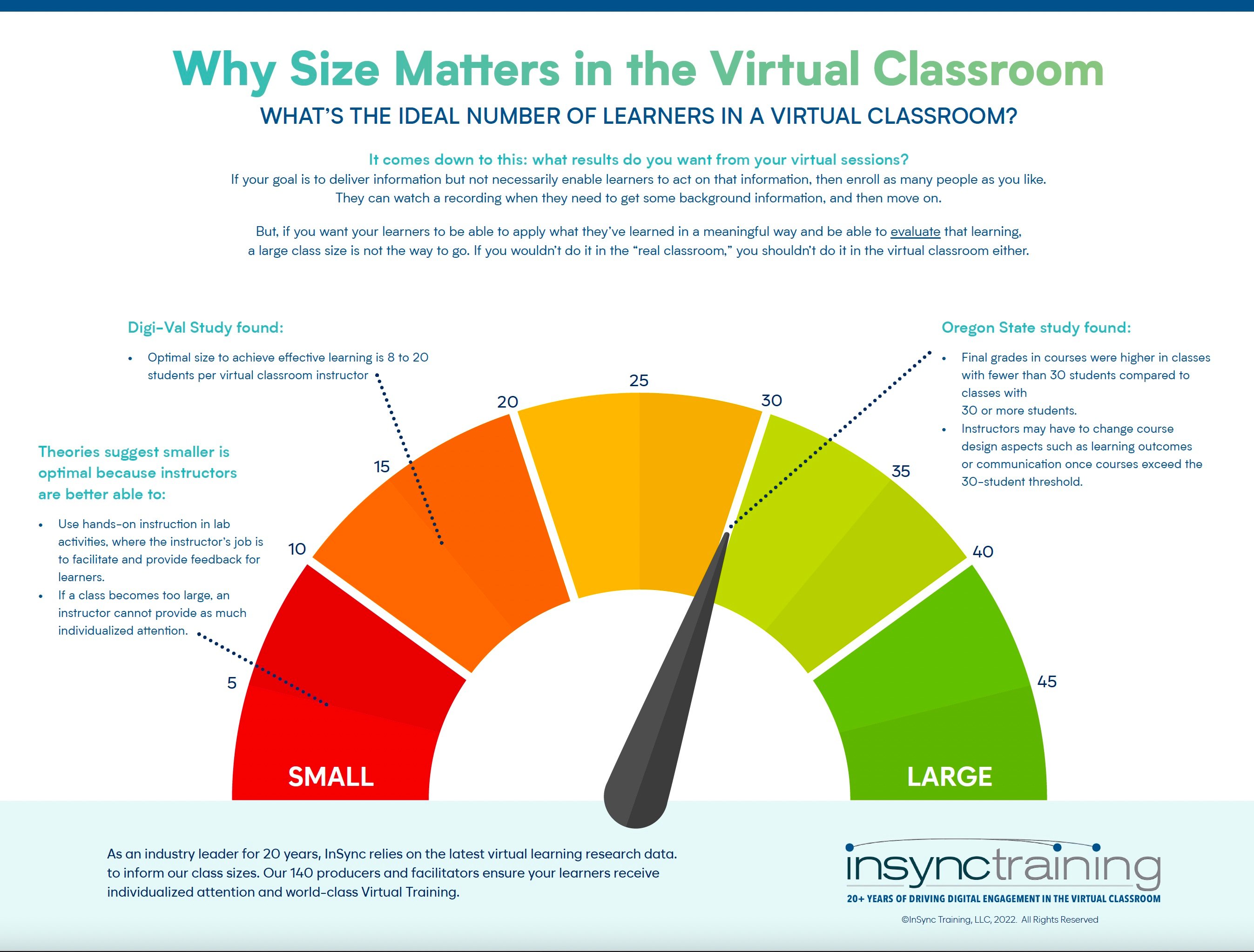5 Valuable Reasons To Keep the Virtual Classroom Size Small
As an industry leader for 20 years, InSync continually relies on the latest virtual learning research data to inform our class sizes. Our 140...
2 min read
InSync Training : Jul 9, 2019 9:38:09 AM

 The virtual classroom offers a flexible, dynamic learning environment for modern learning blends. We often think about questions such as:
The virtual classroom offers a flexible, dynamic learning environment for modern learning blends. We often think about questions such as:
When can we most appropriately incorporate virtual classrooms into our instructional designs?
How do we best leverage virtual classroom tools like chat, breakout rooms, and synchronized web browsing?
What techniques can facilitators use to engage learners when we can’t see them face-to-face?
But one question often gets overlooked: How can the instructional team advocate for virtual learners?
Just like teaching in the traditional face-to-face classroom, instructors should focus not only on delivering content, but also personalizing that delivery. However, in the virtual classroom, doing so without observable body language can challenge even the most experienced facilitators.
So, how can we advocate for learners during the moment to ensure they feel connected to us, to each other, and to the experience? Try one (or all) of these techniques for more nuanced virtual instruction:
Often, instructions offered for virtual classroom activities include technical direction – click here, submit your feedback by, etc. Those with a background in the virtual classroom may quickly understand what is being asked. But learners without experience in the platform or non-native English speakers may need additional guidance. Providing instructions a second time with different wording better supports all participants. If you have a producer (or are acting as one), this provides a fantastic opportunity for a second voice to mix it up.
Have you ever had a virtual classroom activity that fell flat? "Virtual crickets" can and do happen. Keep an eye and ear on activities as they unfold. If you notice participation lagging or contributions missing the mark, jump in and gently redirect by restating expectations. Becoming a learner advocate in the moment requires structure and support. Learners get the most out of training when they can fully participate in a program’s activities.
We strongly believe in the power of instructional partnerships – producers + facilitators = power duos. Our producers model desired behavior in live online events by volunteering for activities or contributing opinions when participation slows. Sometimes learners need a nudge to engage or an example of what "good" looks like. Rather than shaming participants into participating, offer a safe space for engagement.
Learners may get lost in the training shuffle. Minimize this possibility by keeping an eye out for raised hands, questions in chat, or general disengagement. Even if you can’t address a question or comment right away, acknowledge its receipt. Saying something as simple as, “Jane, thanks for your question in chat. I will answer it after this slide.” Or, “John, that’s a great point. I’m going to ask you to come off mute to share it with the group in two minutes.” This demonstrates an investment in the learners’ contributions. Positively reinforcing and encouraging these behaviors encourages learners to share their thoughts, perspectives, and questions.
Becoming a learner advocate in the virtual classroom involves a series of small, purposeful actions that focus on personalization.
Unsure about how to get started? Ask yourself, “What would make me feel connected to this event?” You are a modern learner too, so your ideas can enrich virtual classroom events for your audience.

As an industry leader for 20 years, InSync continually relies on the latest virtual learning research data to inform our class sizes. Our 140...

In the past few years, the term “brain-science” has been used to introduce some new and improved approaches to instructional design and delivery In...
%20Blog.png)
In my previous post, I discussed the importance of strong design for virtual delivery, and how to achieve it. This post addresses the challenges...